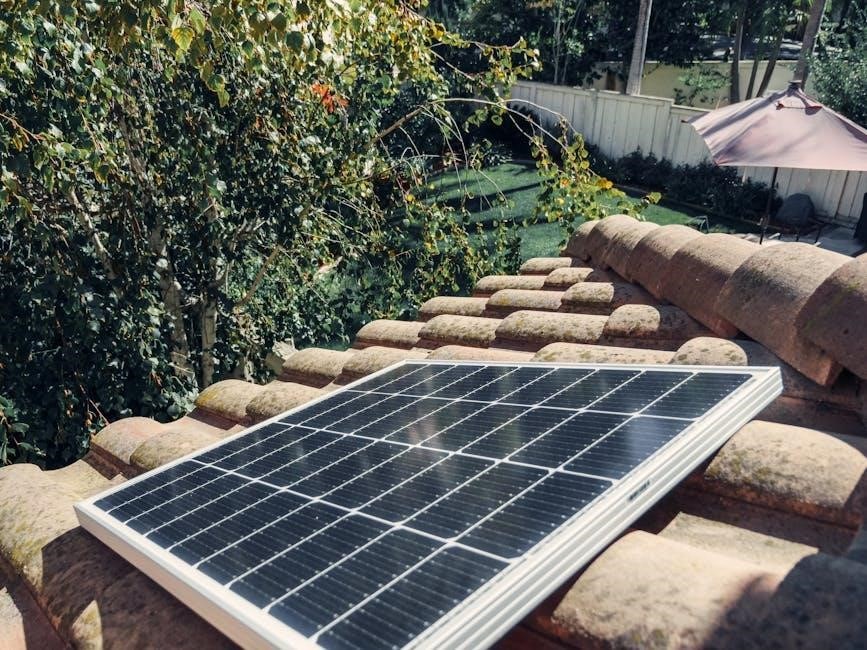An off-grid solar system provides energy independence by harnessing sunlight for power. Wiring diagrams are essential for designing and installing these systems efficiently and safely.
1.1 What is an Off-Grid Solar System?
An off-grid solar system is a standalone renewable energy solution that converts sunlight into electricity without reliance on the main power grid. It consists of solar panels, inverters, batteries, and charge controllers, designed to provide energy independence. These systems store excess energy in batteries for nighttime or cloudy days, ensuring continuous power supply. Off-grid systems are ideal for remote locations or homes seeking sustainability. They offer a cost-effective and environmentally friendly alternative to traditional energy sources. Understanding the components and their connections is crucial for efficient installation and operation, making wiring diagrams essential for proper setup and safety.
1.2 Importance of Wiring Diagrams in Off-Grid Solar Systems
Wiring diagrams are crucial for installing and maintaining off-grid solar systems. They provide a clear visual representation of component connections, ensuring safety and efficiency. A well-detailed wiring diagram helps users avoid common installation mistakes, such as incorrect battery configurations or inverter connections. It also guides the proper sizing of wires and circuit breakers, reducing fire hazards and system failures. Additionally, diagrams aid in troubleshooting issues and optimizing energy flow. By following a wiring diagram, users can maximize their system’s performance and longevity, ensuring reliable energy independence. This makes wiring diagrams indispensable for both novices and experienced installers aiming to build sustainable energy solutions.
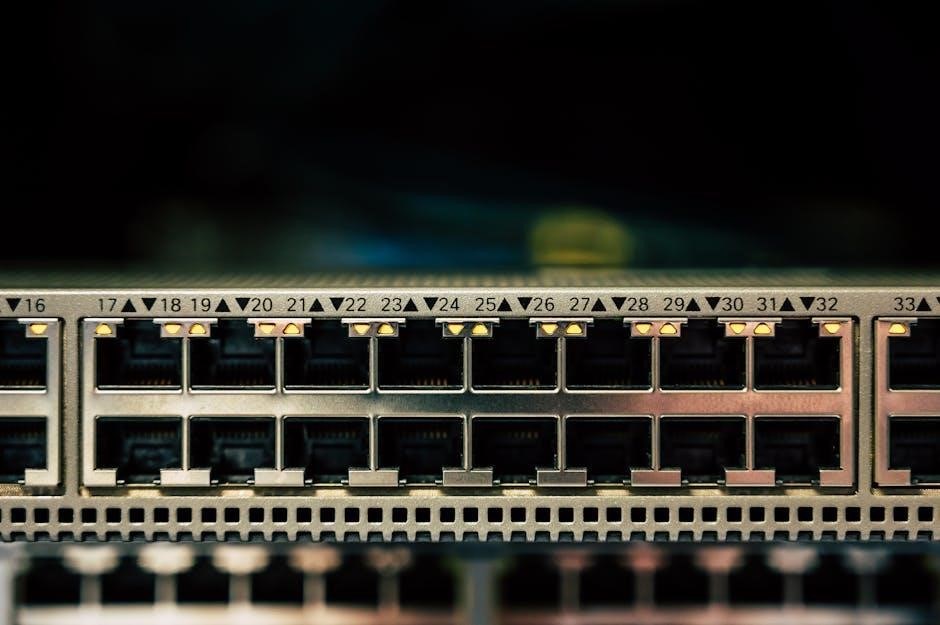
Components of an Off-Grid Solar System
Key components include solar panels, batteries, inverters, and charge controllers. These work together to generate, store, and convert energy for reliable off-grid power solutions.
2.1 Solar Panels and Their Configuration
Solar panels are the backbone of an off-grid system, converting sunlight into electricity. They are typically configured in series or parallel to achieve desired voltage and current levels. A series connection increases voltage, while a parallel setup boosts current. Proper configuration ensures compatibility with inverters and charge controllers. For example, a 7,200W system might use multiple panels connected in a specific array to optimize energy production. The wiring diagram plays a crucial role in illustrating these connections, ensuring safe and efficient energy flow. Correct panel configuration is vital for maximizing system performance and meeting energy demands effectively.
2.2 Batteries and Battery Banks
Batteries and battery banks are essential for storing excess energy in off-grid solar systems. They ensure power availability during nighttime or cloudy days; The wiring diagram illustrates how batteries are connected in series or parallel to achieve the required voltage and capacity. For example, a 28kWh battery bank might consist of multiple deep-cycle batteries configured to meet energy demands. Proper wiring ensures safe and efficient energy storage and release. The diagram also highlights connections to inverters and charge controllers, ensuring compatibility and optimal performance. Correct battery configuration is critical for reliable power supply and system longevity, making it a key component in the wiring diagram.

2.3 Inverters and Charge Controllers
Inverters and charge controllers are critical components in off-grid solar systems. Inverters convert DC power from batteries to AC power for household use, while charge controllers regulate energy flow to batteries; The wiring diagram shows how these components are interconnected, ensuring efficient energy management. For example, the 5,000W inverter in a 7,200W system handles power conversion seamlessly. Charge controllers prevent overcharging, protecting the battery bank and optimizing energy storage. Proper wiring between panels, controllers, and inverters is essential for safety and performance. The diagram also highlights how these components work together to maximize energy efficiency and reliability, ensuring consistent power supply in off-grid setups.
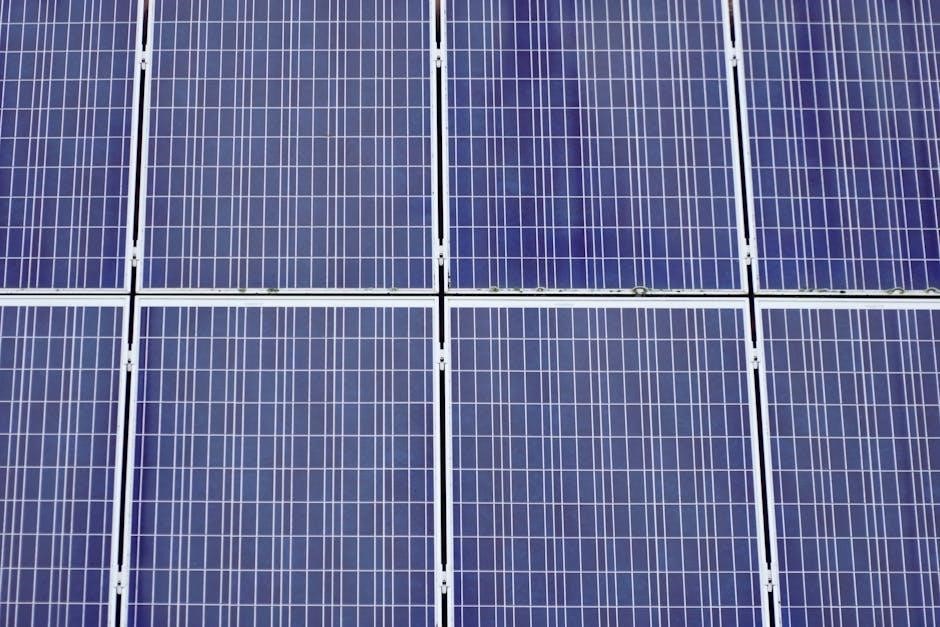
Understanding the Wiring Diagram
A wiring diagram simplifies the installation of off-grid solar systems by providing a clear visual representation of components and connections, ensuring efficiency and safety.
3.1 Schematic Representation of the System
A wiring diagram provides a detailed schematic representation of an off-grid solar system, showcasing components like solar panels, batteries, inverters, and charge controllers. These diagrams illustrate how energy flows from panels to batteries and through inverters, ensuring proper connections. They also highlight safety features like grounding and surge protection. By following the diagram, users can understand how to wire their system efficiently, maximizing energy production and storage. The visual layout simplifies complex connections, making it easier to troubleshoot issues. For example, a 7,200W system with a 28kWh battery bank uses specific wiring configurations to ensure optimal performance and safety. This clear representation is crucial for both installation and maintenance.
3.2 Key Symbols and Notations Used
Wiring diagrams for off-grid solar systems use specific symbols to represent components like solar panels, batteries, inverters, and charge controllers. These symbols are standardized to ensure clarity. For example, a solar panel is often depicted as a circle with rays emanating from it, while a battery is shown as two parallel lines. Arrows indicate the flow of energy, and dotted lines may represent auxiliary connections. Grounding symbols, such as a triangle pointing toward a horizontal line, denote safety connections to prevent electrical hazards. These notations are critical for understanding the system’s layout and ensuring proper installation. They also help in troubleshooting by visually mapping the energy flow and component interactions.
3.3 Step-by-Step Connection Guide
Start by connecting solar panels in series or parallel, based on the system’s voltage and power requirements. Ensure all connections are secure and weatherproof. Next, link the panels to the charge controller, following the wiring diagram to match positive and negative terminals. The charge controller is then connected to the battery bank, ensuring proper polarity to avoid damage. From the battery bank, connect to the inverter, which powers appliances. Finally, connect the load to the inverter, ensuring all safety measures are in place. Use the wiring diagram to verify each connection and test the system step-by-step to ensure proper functionality and safety.

Safety Considerations and Best Practices
Ensure proper grounding and insulation to prevent electrical hazards. Always disconnect power sources before maintenance. Use protective gear and follow voltage safety guidelines to avoid accidents.
4.1 Electrical Safety Tips for Installation
When installing an off-grid solar system, prioritize electrical safety to avoid hazards. Always disconnect power sources before working on the system. Use protective gear like gloves and safety glasses. Ensure proper grounding of all components to prevent electrical shocks. Follow the wiring diagram carefully to maintain correct connections. Avoid overloading circuits and keep wiring organized to reduce fire risks. Regularly inspect components for damage or wear. Never work on the system in wet conditions. Ensure batteries are vented properly to prevent gas buildup. Keep the system away from flammable materials. By adhering to these guidelines, you can ensure a safe and reliable installation process.
4.2 Grounding and Bonding Requirements
Proper grounding and bonding are critical for the safe operation of an off-grid solar system. Grounding ensures electrical currents have a safe path to the earth, preventing dangerous voltages. Bonding connects all metal components, such as solar panels, inverters, and battery enclosures, to ensure they are at the same electrical potential. This reduces the risk of arcing and fire hazards. Follow the National Electric Code (NEC) guidelines for grounding and bonding. Use appropriately sized wires and connect them to a grounding rod or plate. Regularly inspect grounding and bonding connections for corrosion or damage. Proper installation ensures system safety, efficiency, and compliance with electrical standards.
4.3 Avoiding Common Wiring Mistakes
Common wiring mistakes in off-grid solar systems can lead to inefficiency, safety hazards, or even system failure. One frequent error is incorrect wire sizing, which can cause voltage drop or overheating. Another mistake is improper connections between components, such as loose terminals or reversed polarity. Additionally, inadequate labeling of wires can lead to confusion during maintenance or troubleshooting. To avoid these issues, always use a detailed wiring diagram specific to your system. Double-check connections for tightness and correctness, and ensure proper insulation. Regularly test circuits and consult NEC guidelines for compliance. Proper wiring practices ensure safety, reliability, and optimal performance of your off-grid solar system.

Case Study: 7,200W ౼ 28kWh ⎼ 5,000W ౼ 120V System
This case study examines a 7,200W solar array, 28kWh battery bank, and 5,000W inverter system, operating at 120V. It demonstrates a practical off-grid configuration supporting heavy loads, with a detailed wiring diagram ensuring proper installation and energy efficiency.
5.1 System Overview and Specifications
This off-grid solar system is designed to provide reliable energy for a large-scale setup, featuring a 7,200W solar array, 28kWh battery bank, and a 5,000W inverter/charger. The system operates at 120V, making it suitable for high-power applications. The solar panels are configured in parallel to maximize energy production, while the battery bank ensures extended backup during periods of low sunlight. The inverter/charger efficiently manages power conversion and charging, ensuring a stable energy supply. This configuration supports heavy loads, including appliances and machinery, while maintaining energy efficiency and reliability. The system is ideal for remote locations or homes requiring consistent off-grid power.
5.2 Detailed Wiring Diagram for the System
The wiring diagram outlines the connections between the 7,200W solar array, 28kWh battery bank, and 5,000W inverter/charger. Solar panels are connected in parallel to the charge controller, ensuring maximum energy capture. The charge controller feeds the battery bank, which stores excess energy for nighttime or cloudy days. The inverter/charger converts stored DC power to AC for household use and charges the batteries when grid power is available. The diagram also shows connections to AC and DC distribution panels, ensuring safe and efficient energy distribution. Grounding points and safety devices like fuses and breakers are highlighted for system protection. This clear layout minimizes installation errors and ensures compliance with electrical standards.
5.3 Performance and Energy Efficiency
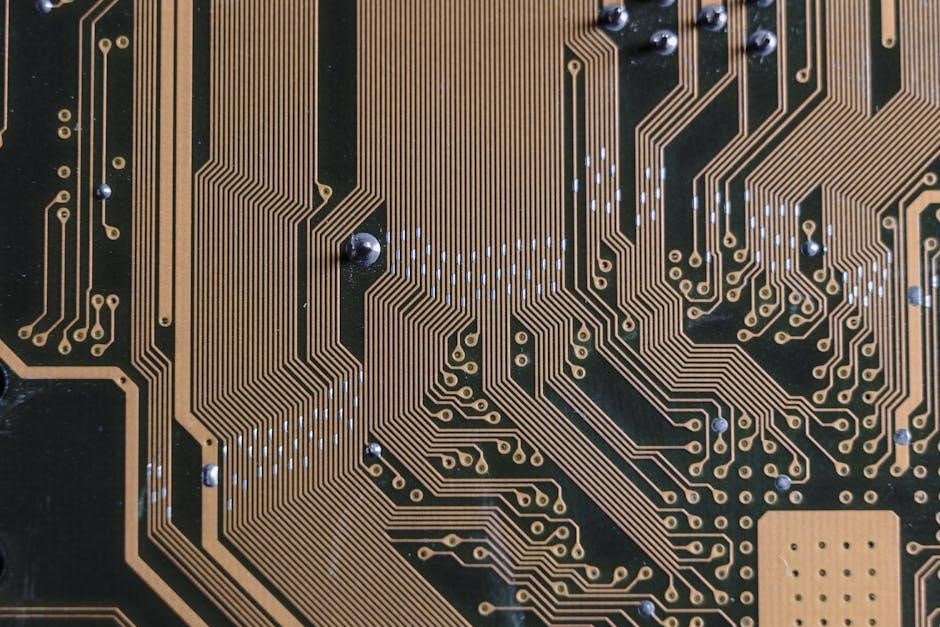
The 7,200W off-grid solar system achieves high performance and energy efficiency, with a total storage capacity of 28kWh. The system ensures optimal energy utilization through advanced charge controllers and inverters, minimizing power losses. Solar panels operate at 20% efficiency, while the inverter achieves 95% efficiency during conversion. The battery bank maintains a depth of discharge of 50% to prolong lifespan. Overall, the system delivers an average efficiency of 80-85%, ensuring reliable power supply. Factors like temperature and shading are accounted for in the design. Proper installation and maintenance further enhance performance, making this system a robust solution for off-grid energy needs.
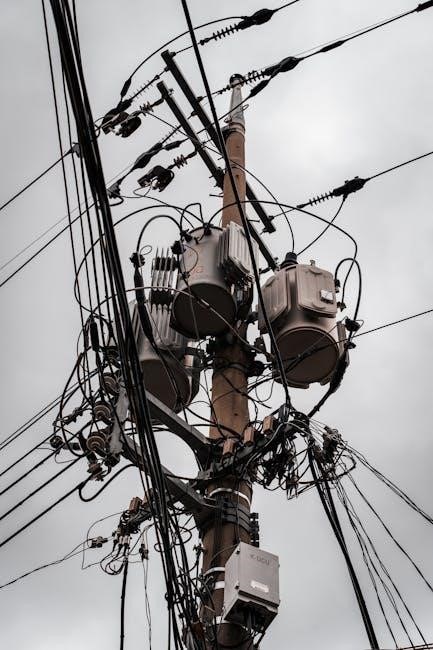
Designing and Sizing Your Off-Grid System
Properly sizing your off-grid system ensures reliability and efficiency, starting with load calculation and energy requirements. Component selection, including panels, batteries, and inverters, must align with your needs. A well-designed system optimizes performance, reduces costs, and enhances sustainability, ensuring long-term energy independence.
6.1 Calculating Energy Requirements
To design an efficient off-grid solar system, start by calculating your energy requirements. Assess your daily energy loads, including lights, appliances, and devices. Measure power ratings and usage hours for each item to determine total daily consumption. Consider peak demand and seasonal variations. Multiply daily energy needs by 1.1-1.2 to account for inefficiencies. Use solar irradiance data for your location to size the solar array appropriately. Ensure the battery bank can store at least 1-2 days of backup energy. Accurate calculations ensure your system meets demand reliably, avoiding undersizing or oversizing, which can lead to performance issues or unnecessary costs. Proper sizing is critical for long-term energy independence.
6.2 Selecting the Right Components
Selecting the right components for your off-grid solar system is crucial for optimal performance. Start with solar panels that match your energy needs and space constraints. Choose monocrystalline or polycrystalline panels based on efficiency and cost. For batteries, deep-cycle lithium-ion or lead-acid options are common, offering varying lifespans and maintenance requirements. Inverters must handle your maximum power demand, converting DC to AC efficiently. Charge controllers ensure proper charging and protection of your battery bank. Mounting structures, wiring, and disconnects are also essential. Always prioritize high-efficiency components and compatibility to ensure seamless operation. Proper component selection ensures reliability, safety, and long-term energy independence, aligning with your system’s design and energy requirements.
6.3 Optimizing System Performance
Optimizing your off-grid solar system’s performance ensures maximum energy efficiency and reliability. Regularly monitor energy production and consumption to identify inefficiencies. Adjust settings on inverters and charge controllers to match your load requirements. Ensure proper wiring connections as per the wiring diagram to minimize energy losses. Perform routine maintenance, such as cleaning solar panels and checking battery health. Optimize system configuration by angling panels correctly and shading-free placement. Use energy-efficient appliances to reduce demand. Implement smart charging strategies to maximize battery lifespan. Regularly review and update your system to adapt to changing energy needs. These steps ensure your off-grid solar system operates at peak performance, providing consistent and reliable energy supply while minimizing operational costs and extending component lifespans.
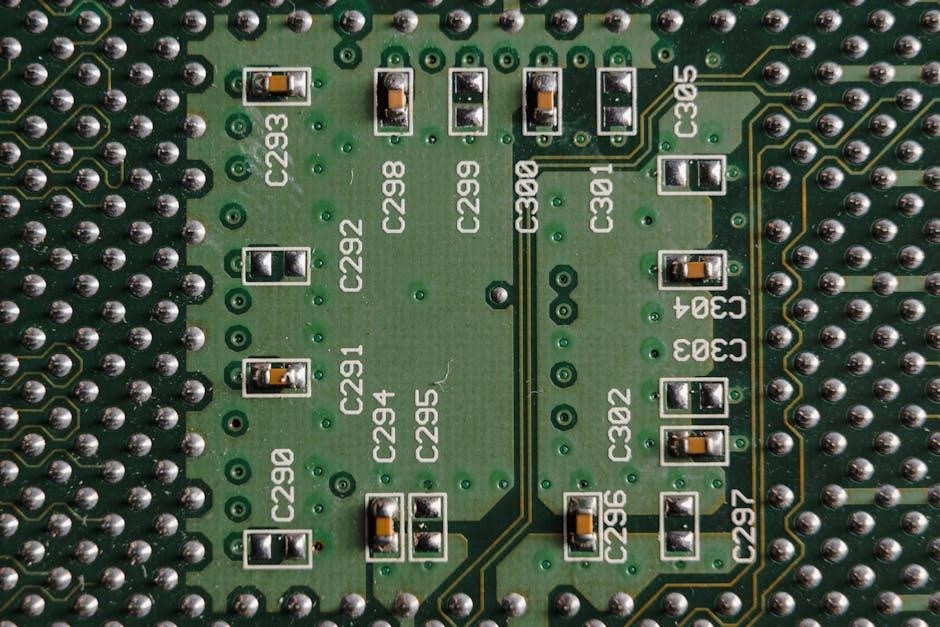
Benefits of Using a Wiring Diagram
A wiring diagram simplifies installation, enhances safety, and ensures efficiency. It provides clear connections, reduces errors, and aids in troubleshooting. Proper diagrams minimize risks and ensure compliance with standards, making your off-grid solar system reliable and long-lasting while optimizing performance and energy use.
7.1 Ensuring Energy Efficiency
A wiring diagram plays a crucial role in ensuring energy efficiency for off-grid solar systems. By providing a clear blueprint of connections, it minimizes energy losses and optimizes power flow; Properly routed wires reduce voltage drop, ensuring maximum energy transfer from solar panels to batteries and inverters. This precise configuration also helps in identifying and avoiding power mismatches, which can lead to inefficiencies. Additionally, a well-designed diagram ensures that charge controllers and inverters operate within their rated capacities, maximizing energy conversion and storage. This systematic approach not only enhances overall efficiency but also supports long-term reliability and performance of the off-grid solar system.
7.2 Reducing Installation Costs
A detailed wiring diagram significantly reduces installation costs by streamlining the process and minimizing errors. It provides clarity on connections, ensuring installers understand the system layout without costly trial-and-error. This clear blueprint reduces labor time, as technicians can follow a structured plan rather than figuring out wiring configurations. Additionally, it helps in identifying the exact components needed, preventing over-purchasing or under-specifying equipment. By optimizing the system design upfront, a wiring diagram avoids costly rework or redesigns down the line. This precision not only saves money but also ensures the system operates efficiently, further lowering long-term energy expenses and enhancing overall cost-effectiveness.
7.3 Enhancing System Reliability
A wiring diagram plays a crucial role in enhancing the reliability of an off-grid solar system by providing a clear, visual guide for installation and maintenance. It ensures that all components are interconnected correctly, minimizing the risk of electrical faults and system failures. By following the diagram, installers can avoid misconnections that might lead to equipment damage or safety hazards. Additionally, it serves as a reference for troubleshooting, allowing technicians to quickly identify and resolve issues. This standardized approach ensures consistency and reduces human error, resulting in a more dependable and long-lasting solar energy system. Reliability is further enhanced through proper connections and component compatibility.

Resources for Further Learning
Explore trusted websites, educational guides, and PDF resources for wiring diagrams. Utilize tutorials, forums, and manuals to deepen your understanding of off-grid solar systems and their configurations.
8.1 Free PDF Downloads for Wiring Diagrams
Access comprehensive PDF guides for off-grid solar wiring diagrams from trusted sources. Websites like Renusol, SimpliPhi Power, and Schneider Electric offer detailed schematics. These resources cover configurations for solar panels, inverters, and battery banks. Download manuals that include step-by-step instructions for safe and efficient installations. Many forums and renewable energy communities also share free PDFs tailored for DIY projects. Use search terms like “off-grid solar wiring diagram PDF” to find reliable downloads. These resources are essential for ensuring your system is installed correctly, adhering to safety standards and optimizing energy efficiency.
8.2 Online Guides and Tutorials
Explore a wealth of online guides and tutorials dedicated to off-grid solar wiring diagrams. Platforms like YouTube and Renewable Energy Forums offer detailed step-by-step videos and articles. Websites such as Solar Power Europe and Off-Grid Energy provide interactive tools and downloadable resources. These guides cater to both beginners and experienced installers, covering topics like system design, wiring best practices, and troubleshooting. Many tutorials include visual aids, such as diagrams and schematics, to simplify complex concepts. Utilize these resources to enhance your understanding and ensure a safe, efficient installation of your off-grid solar system.
8.3 Community Forums and Expert Advice
Engage with community forums and expert advice to deepen your understanding of off-grid solar wiring diagrams. Platforms like Reddit’s r/offgridsolar and Solar Panels Forum offer valuable discussions and peer-reviewed insights. Experts often share real-world experiences, providing practical tips for troubleshooting and optimizing systems. These communities are ideal for addressing specific challenges or verifying designs before implementation. Many forums also host experienced professionals who can review your wiring diagram and offer tailored advice. Participating in these discussions ensures you gain insights from a collective knowledge base, helping you avoid common pitfalls and achieve a reliable, efficient off-grid solar setup.
